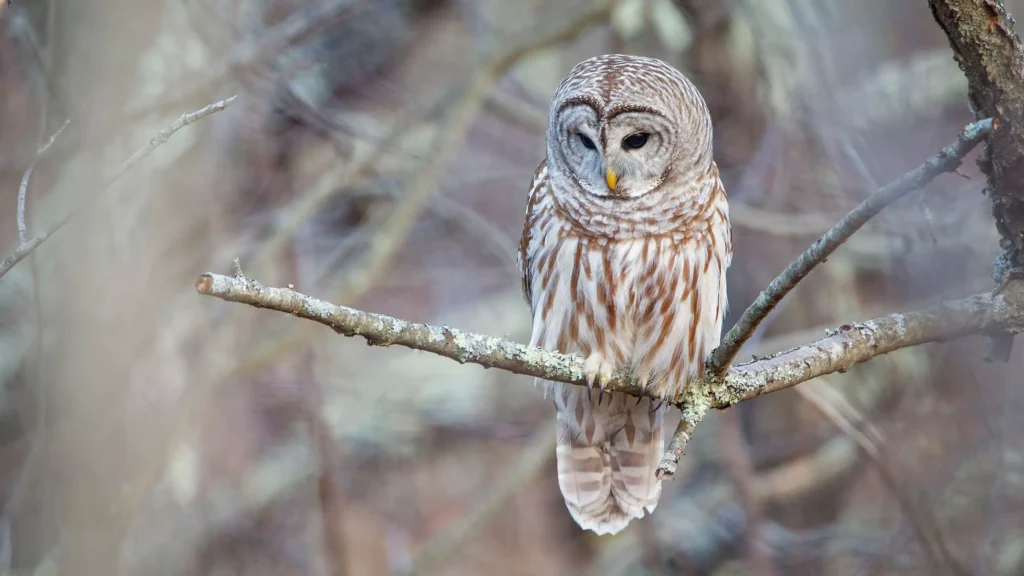Groups plan for litigation against USFWS as the agency begins implementation of flawed plan, devoid of cost estimates or explanation on who and how mass killing to be conducted
Washington, D.C. — Leading animal welfare groups today charged that the U.S. Fish and Wildlife Service (USFWS) plan to kill upwards of 450,00 barred owls is costly, unworkable, and inhumane. Despite the agency’s attempts to demonize barred owls, the animals are native to North America and protected by the Migratory Bird Treaty Act. Like hundreds of other avian species, they have engaged in range expansion, a process that is accelerating with climate change and other human disturbances of the environment.
Yesterday, officials with USFWS signaled that the agency would give final administrative approval to the plan today. Today, Animal Wellness Action and the Center for a Humane Economy give notice that they will fight the plan in the federal courts and in Congress.

Animal Wellness Action and the Center for a Humane Economy have organized 164 animal welfare, conservation, and birding organizations opposed to the kill and urged the White House to pull back on the plan. There are 20 Audubon Society chapters that oppose the mass raptor kill, including several in Washington state. That letter is here.
“The Fish and Wildlife Service is proposing the largest-ever plan to slaughter raptors anywhere in the world, and by a country mile,” said Wayne Pacelle, president of Animal Wellness Action and the Center for a Humane Economy. “The agency is stepping onto a killing treadmill that it can never dismount. The two outcomes likely to result from the plan are a massive body count of barred owls and no long-term improvement in the survival prospects of spotted owls.”
“The control area of 24 million acres is too vast, and even when birds are killed, survivors will quickly reclaim nesting sites and social competition between owl communities will continue,” added Pacelle. “Every caring person wants to save spotted owls from extinction, but a strategy to kill a half-million look-alike forest owls must be taken off the table as violating our norms about proper treatment of any native owl species in North America.”
Recently, Hilary Franz, the public lands commissioner of Washington, came out in opposition to the plan. “How can we prevent the surviving barred owls from simply recolonizing and repopulating the very areas we are trying to preserve? I think we can do better, and we have too many questions that need to be answered,” Franz said.
On a recent webinar about the barred owl kill plan, former U.S. Fish and Wildlife Service wildlife biologist Kent Livezey estimated the cost of killing 450,000 barred owls at more than $225 million— making it one of the most expensive threatened or endangered species management projects ever. There will be costs for training, weapons, ammunition, and labor time spent killing owls, many of whom inhabit roadless wilderness areas and other areas difficult to access.
In one of his dozen peer-reviewed publications concerning the competition between these two species, Livezey noted that no more than 40 raptors had been killed annually to address negative effects between raptors and other native birds in the United States. The agency’s final Environmental Impact Statement proposes to kill nearly a half a million barred owls, which is 12,000 times more than that. “To say that this is unprecedented is an understatement,” said Livezey, who also wrote a paper documenting that 111 native bird species in North America have engaged in recent range expansion, with 14 of them dispersing more widely than barred owls.
Kill Plan Susceptible to Legal Challenge
Animal Wellness Action and the Center for a Humane Economy pledged to urge Congress to scuttle the plan but also promised to sue to halt the scheme in federal court.
The USFWS’s EIS suffers from several defects which make it susceptible to a legal challenge. As part of its “reasonable alternatives” analysis, USFWS was required to take a “hard look” at alternatives to the approach it ultimately decided to take. Instead, the agency unreasonably and summarily rejected several alternatives that did not involve the mass killing of barred owls—options like nonlethal barred owl population control, species relocation, and spotted owl breeding programs. For example, USFWS rejected a barred owl reproduction-interference alternative because it “could require well over a decade” while ultimately adopting one that will take at least 30 years.
“We don’t hunt orcas in Puget Sound when they predate on struggling salmon populations,” said Jennifer McCausland, senior vice president of the Center for a Humane Economy, who is based in Seattle. “Rather than adopting a ‘killing fields and forests’ approach to barred owl management, the USFWS should focus on protecting habitats, as it’s trying with chinook salmon, and focus on protecting intact forests for the long-term health of spotted owls.”

